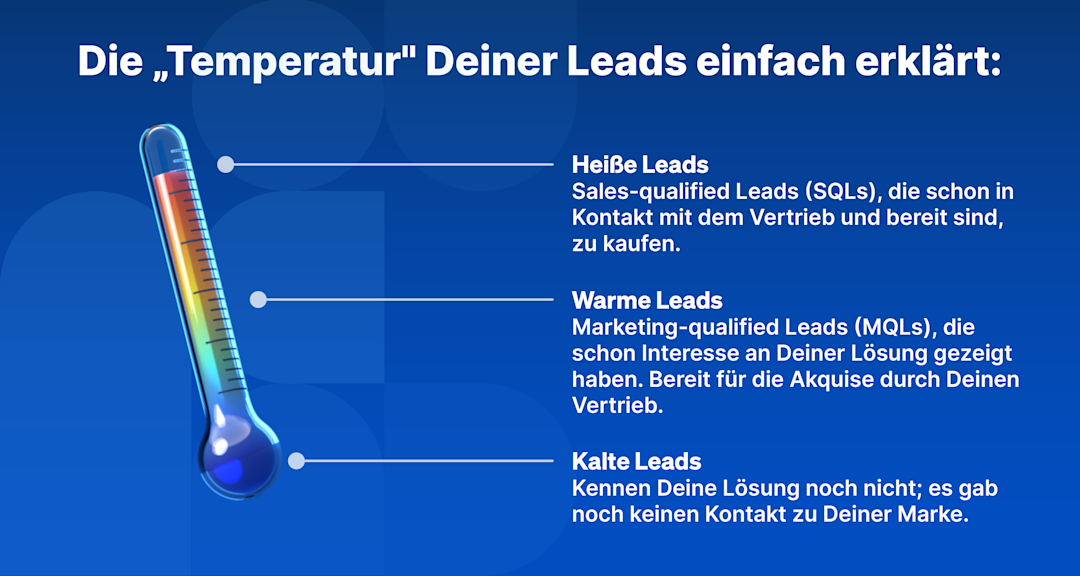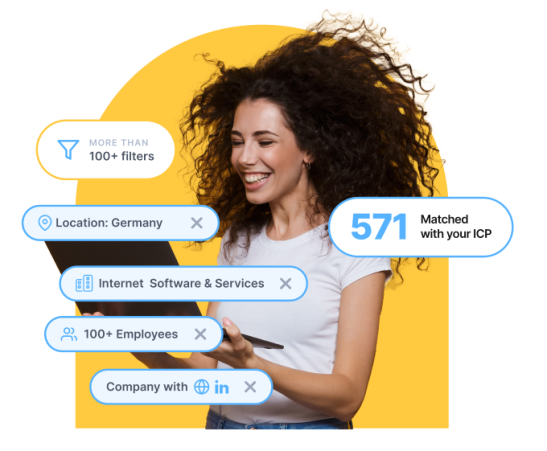Does your competition seem to know about a secret source of untapped customers that you just can’t find? Then the time has come to refresh your search for elusive customers and keep your company profitable!
We’re going to talk about business leads and share tips for generating more B2B leads to help you stay at the forefront of your very competitive industry. By managing your leads effectively, you can increase the number of converted customers, which is vital for your revenue stream.
That said, generating business leads is one thing—but what do you do after you get them? We'll explore these types of questions, too, and give you some pointers that you can put to use right away as you move through the lead management process and uncover hidden customers.
With valuable B2B leads in your sales pipeline, you’ll be ready to increase your sales. So strap in and learn the tricks of the trade.
What are leads in business?
In the business world, a lead refers to an individual or organization that has shown interest in your company's products or services. These potential customers have usually interacted with your brand through various channels, such as your website, social media, or advertising campaigns.
But it doesn’t necessarily need to have gone that far. A prospect may never have heard of you, but if they meet your ideal customer profile, you could be on to a winner. We call these cold leads, and they just need some warming up.
Whatever the case, leads are essential for any business looking to grow its customer base and increase revenue.
Examples of business-to-business leads
A company that completes a contact form on your site asking for more information on your services.
Someone who downloads a whitepaper or an eBook after signing up for your content via an email form.
An organization that shows up to your webinar or trade show booth and expresses a need for your product.
Why are business leads important?
Every company needs business leads to not only survive but to grow. Check out a few benefits of having a consistent flow of leads for your business:
More sales: When you convert your leads into buying customers, your sales increase along with the revenue.
Broader client base: Leads help you get more customers, increasing your client base and market share.
Enhanced brand awareness: With every new buyer, your brand awareness goes up, and it’s easier to attract more business opportunity leads in the future.
Improved sales efficiency: By concentrating on qualified leads, your sales team will be able to prioritize their sales activities and close more business.
Competitive advantage: Generating a steady supply of quality leads can help you differentiate yourself from competitors who are scrambling to drum up new business.
What makes a good business lead?
To ensure that your sales team is working on the right prospects, it's essential to figure out what constitutes a good new business lead.
Fit: A lead is a good fit if they match your ideal customer profile, meaning they need your products or services and have enough resources to buy them.
Interest: The lead should have shown active interest in your brand by clicking on links, signing up for your content, attending events, or requesting more information.
Authority: The contact person should be someone who approves or has influence over purchasing decisions within their organization.
Timing: Your lead must have a current need for what you are selling and be willing and able to buy or move forward within a timeframe you find reasonable.
Whenever a lead fulfills these requirements, that lead is more likely to become sales qualified, so it’s worth investing in.
How to identify a qualified lead
Qualifying your leads is important to properly optimize your sales funnel and make sure your team is focusing on the right accounts. Here are some of the key factors to look for when qualifying a lead.
Budget: Consider whether the lead has the money to afford your products or services.
Authority: Check that the contact you have is someone who has the right to make a buying decision.
Need: Does the lead have a real need, and if so, is your offer well-suited to address the pain?
Timeline: Establish the lead's purchasing time frame and whether it aligns with your sales cycle.
By considering these attributes when you evaluate leads, you’ll be able to focus on the ones likely to convert and assign your resources accordingly.
Six types of B2B leads
B2B leads at different stages in the buying process shouldn’t all be treated the same. Understanding these various lead types can help you better manage your interaction with customers and increase your chances of converting leads.
Let's explore six common types of B2B leads and how to effectively nurture them.
Cold leads
Cold leads are people who have not engaged with your brand before. They might not even know you exist. Approaching cold leads requires a strategy that builds brand awareness and educates them about your products and services.
Warm leads
Warm leads have at least a bit of interest in your brand. They’ve visited the website or engaged with your social media content. They know who you are, but they’re not ready to buy. Nurturing warm leads helps build the relationship by offering helpful content that keeps your brand at the forefront of the prospect’s mind.
Hot leads
A hot lead has previously made contact with your sales team and is highly engaged, so you know that they want what you’re selling. They might have already demonstrated interest in a demo, trial, or consultation, which means that they’re likely about to make a purchase. Address their specific needs right away to help them get to the finish line.
Information qualified leads (IQL)
IQLs are inquiries who have exchanged contact information for access to content or resources, like whitepapers, e-books, or webinars. They might not be ready to buy, but they are interested in learning about your industry or solutions. Keep nurturing these leads with valuable content to build trust.
Marketing qualified leads (MQL)
MQLs are leads that have interacted with your marketing and meet your demographic and behavioral criteria. They are more conversion-ready than cold or warm leads and may just need a little more nurturing before they’re sales-ready.
Sales ready/accepted leads (SRL)
SRLs are sometimes referred to as SQLs (sales-qualified leads), meaning that both marketing and sales teams have agreed that the leads are now ready to engage with sales.
Usually, an SRL has a demonstrated interest in your solutions, is ready to buy, has the budget and authority to purchase, and fits (or is close to) your ideal customer profile. Hit these leads with the sales bat. Hard.

How to get leads for your business with seven foolproof strategies
Lead generation is one of the most important elements of any B2B sales pipeline. If you want to be successful in today’s business environment, you need a whole host of techniques at your disposal that will help you attract and engage prospects.
Let's discuss seven fail-safe ways to get leads for your business and keep your sales team busy closing business.
1) Social selling on LinkedIn
LinkedIn is a goldmine for B2B lead generation. Optimize your profile, share relevant content, and engage with your target market to build your credibility as a thought leader, and the potential clients will find you. Use LinkedIn’s advanced search feature to identify decision makers by job title, industry, and company, and engage them to start the ball rolling.
2) Sponsored ads
Paid advertising, such as on Google, Facebook, and LinkedIn, can help reach a larger audience and boost targeted leads. You can write relevant ad copy and create attractive landing pages to invite such prospects to leave their contact information in return for valuable content and offers.
3) Referrals
Word-of-mouth is one of the most powerful lead generation tools. Ensure that your satisfied customers refer their colleagues and industry contacts to you, and consider a referral program that pays referring customers for each new lead provided.
4) Cold outreach
The old-school techniques of cold calling and emailing still have a place if done well. Make the communication personal, make it about value, and don’t ask for the sale right away. Use tools such as email templates and call scripts.
5) Content
A content marketing strategy can help you attract and nurture leads over time. You can attract and nurture leads by making valuable blog posts, whitepapers, e-books, and webinars available over time. Gate your premium content behind a form that captures a lead’s contact information.
6) Retargeting
With retargeting, you can target people who have already shown interest in your brand. All you need is a pixel on your site, and you can show the people who have visited your site ads as they browse around the internet, keeping your brand top of mind and ready to convert.
7) Buying leads
Sometimes, it pays to pay for a quality B2B lead database to grow your sales pipeline. If you choose to buy leads, make sure you are getting them from a reputable provider of leads for sale, who delivers targeted, clean, and current information.
Buying lead lists will save you time and money that would otherwise be wasted on sales teams having to hunt for prospects.
What to do when you get a business lead: the lead management process
Generating leads is just the first stage in the sales cycle. When you do have a lead, you need to make the most of it to increase your chances of converting that lead. Managing your leads well can help you qualify, nurture, and convert your leads to eventually become sales-qualified leads and customers.
Let's break down the key stages of the lead management process.
Lead research
When you get a new lead, spend the time to research the company, the industry, and the likely role of the prospect. Look at their website, their social media profiles, and news articles. What are their needs and challenges, and how might your products or services fit?
Lead qualifying
Not every lead is worth a conversation. Qualify your leads based on BANT (Budget, Authority, Need, and Timeline). Ask questions about their requirements, budget, decision power, and time to purchase. Work on qualified leads only—leads that meet your target customer profile.
Lead nurturing
Not all leads are sales-ready right away. This is where lead nurturing comes in.
Create a series of touchpoints, emails, phone calls, and content (lead magnets), to keep your brand relevant and build trust over time.
Personalize both your messaging and CTAs based on their persona, interest, or behavior, and provide value at every touchpoint so that you can nurture your leads with the right content across multiple channels.
With proper nurturing, you can take your leads through the buying journey and transform them into customers.
Lead generation trends for 2024
To remain competitive and attract the best leads, companies need to be on top of future trends and technologies. Here are the five top lead generation trends you should expect in 2024:
1. AI-powered lead generation
Artificial intelligence (AI) is set to revolutionize the way businesses generate and qualify leads. AI allows you to track and analyze substantial amounts of data, identify patterns, and predict which of your leads is more likely to convert. It can make your lead generation process not only faster but also smarter. AI can help you personalize, prioritize, and focus on the leads most likely to convert.
2. Conversational marketing
Conversational marketing in the form of chatbots, live chat, and messaging apps has been widely accepted as a lead generation technique.
With conversational marketing, brands can deliver instant, tailored responses to queries, lead customers along the funnel in real time, and position themselves as helpful and responsive resources.
As consumers become increasingly impatient with long delays and poor online experiences, conversational marketing will be a must-have for B2B organizations.
3. Interactive resources
Static content will no longer be enough to convert B2B leads as we move into 2024. Interactive content like quizzes, assessments, calculators, or webinars will be crucial to both engaging prospects and gathering data.
Businesses that figure out how to construct these types of rich, interactive experiences that provide unexpected or surprising value and insights will certainly separate themselves from competitors and boost their relationships with prospective customers.
4. Account-based marketing (ABM)
Account-based marketing (ABM) is a highly targeted tactic. It begins with the identification of high-value accounts, moves on to developing intelligent and tailored campaigns to engage those targets, and then converts the sales accordingly. All of this works by synchronizing marketing and sales.
The rise of competition will make ABM even more relevant for B2B companies that need to generate quality leads and increase revenue growth in 2024.
5. Video marketing
As a lead generation tool, video is already powerful, and that’s likely to get stronger in 2024.
Whether it’s a product demo, explainer video, customer testimonial, or thought leadership content, video can achieve all three of the following aims for a business: cut through the clutter, enhance credibility, and deepen relationships with leads.
For B2B companies, incorporating video into their lead generation strategies will no longer be optional as video technology proliferates and becomes more cost-effective.
What to look for when deciding on a B2B leads database
Investing in a high-quality B2B leads database can be a game-changer for your sales and marketing efforts. The big question is: Where do you start? There are quite a few contenders out there.
Here are four determinant factors when choosing a B2B leads database and how Dealfront stacks up:
Data accuracy and completeness: If you want to get the best results from your lead-generation campaign, you have to work with the best data. Find a provider that offers a high level of precision and accuracy in what they provide. Dealfront prides itself on providing highly accurate and complete B2B data, with 100+ filters that make it easier to find your target customer.
Compliance and security: With strict data privacy regulations like GDPR in place, it’s essential to pick a B2B leads database provider that’s very particular about compliance and security. Make sure that they source the information ethically and store it securely. Dealfront is fully GDPR compliant. We only source our data from open online sources, such as official trade registers, and enrich it with public web data. This data is then processed and stored on European servers.
Ease of use and integration: Your B2B leads database must be easily accessible and integrate with your existing sales and marketing tools. It should be easy to use, provide powerful search functionality, and work seamlessly with your existing customer relationship management (CRM) platform. Dealfront allows you to zero in on your best prospects with its easy-to-use, intuitively designed platform with highly customizable filtering options and CRM integrations built-in as native features.
Additional features and insights: As important as a comprehensive database is, extra features and insights can give you an edge over your competitors. Make sure your provider offers value-added services such as buyer intent signals, web visitor tracking, and recommended companies based on AI at no extra charge Dealfront delivers more than just data to you, for example trigger event alerts and lookalike company recommendations, as well as B2B advertising, so you can discover, engage, and convert your most valuable prospects.
Using a Dealfront B2B sales leads database, with the best data accuracy, legal compliance, and user-friendly interface in the market, along with more in-depth insights, you can fast-track your lead generation strategy and create a smoother sales pipeline.
Generate business leads your sales team will thank you for with Dealfront
With the fierce competition in B2B sales, attracting and converting great leads is crucial to success. Dealfront offers a comprehensive solution that can help you revamp your lead creation and conversion strategies and also keep your sales team motivated and on track.
With Dealfront, you can access accurate and up-to-date B2B company and contact data. This means you can search for decision-makers and quickly connect with them to accelerate your outreach to the business prospects that matter to your business goals. Dealfront’s intuitive filtering options will also help you narrow down your prospects and align them with your product or service offerings.
But don't just take our word for it—book a demo today and find out how Dealfront can revolutionize your lead generation and make your sales team thrive.
FAQs about business leads
What is the difference between a business lead and a prospect?
A business lead is a person or company that has an initial interest in your products or services. This can manifest in several ways, such as signing up to receive communications from you, downloading a gated asset, requesting a demo, or registering for a webinar. A prospect is a lead who has been qualified according to a set of criteria, such as budget, authority, or timeline. Prospects are more likely to convert to a customer than a general lead.
What role do lead management systems play in lead generation?
Lead management systems like customer relationship management (CRM) software help you organize, track, and analyze your leads throughout the sales cycle. You use lead management software to store leads’ contact information, record interactions, set reminders, and automate many of your follow-up tasks.
How can businesses measure the effectiveness of their lead generation efforts?
Key metrics that you should be tracking regularly include: the number of leads generated, lead-to-customer conversion rate, cost per lead, cost per acquisition (Customer Acquisition Cost, or CAC), and return on investment (ROI) for each of your lead generation channels. Tracking these metrics would help you understand which channels are working well and which are not.
What strategies can businesses use to convert leads into customers?
Once you get leads into your funnel, you need conversion strategies to turn them into paying customers. Personal follow-up, lead nurturing, social proof, demonstrations, trials, and proactive communication are all techniques that can be used to build relationships with leads and lead them to purchase.




